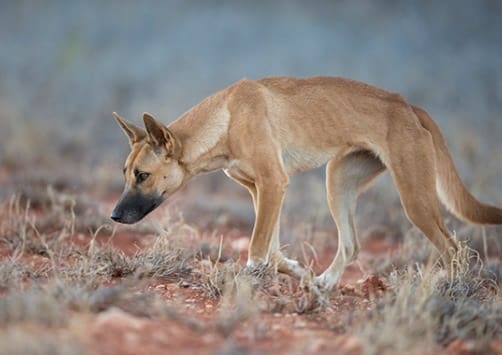
A dingo or wild dog. Image – PIRSA.
A PROPOSAL to monitor dingo movements with radio collars in north-west Victoria has won the support of Minister for Primary Industries and Regional Development Clare Scriven.
National Wild Dog Management co-ordinator Greg Mifsud has suggested the Victorian Government use radio collars to monitor dingo movements in and around the north-west’s Big Desert National Park to gain information on the behaviour, numbers and ecology.
Support to take the proposal to Victorian Minister for Agriculture Ros Spence has come from the Mallee and Yanac-Broughton Landcare groups, Victorian Farmers Federation Livestock vice-president Peter Star and farmers in the area, after the State Government effectively gave full protection to dingoes by removing an unprotection order in March, leading to increased attacks on sheep flocks.
Mr Mifsud said the proposal was well-received by the Minister Spence’s advisers, and Department of Energy, Environment, Climate Action and Agriculture Victoria officers, who said they would investigate the proposal and other options before making any commitments.
Mr Mifsud said the government officers saw the value in getting more information about the dogs and anything that might assist in limiting dingo-landholder conflict.
He said the radio tracking project would minimize the anxiety expressed by landholders who currently don’t know where the dogs are and who will get attacked next.
“The concern that landholders have is that they don’t know where those dogs are in relation to their livestock.
“New technology such as “geofencing” can alert landholders when collared dingoes cross their boundary so they can manage stock appropriately to avoid conflict.”
At the recent LambEx conference in Adelaide, Minister Scriven said the SA Government was disappointed with the Victorian Government’s decision to remove the unprotection buffer around park areas in north-west Victoria.
But Ms Scriven was supportive of the radio collaring proposal.
“I think that science should always underpin the decisions on these sorts of matters.
If there are opportunities to get better data then that’s always going to be a good thing.
She said surveys in South Australia indicate that wild dogs are not facing extinction and were still prolific despite years of baiting.
“If there are other opportunities to get increased data then that can only be a good thing.”
North-west Victorian sheep producer Allan Bennett said the State Government had not yet committed to the collaring proposal, but are considering catching some dogs and putting collars on them.
Mr Bennett said it has also been suggested that the Victorian Government’s $550,000 extension support package for north-west producers be used to facilitate the capturing and collaring of dogs.
Mr Bennett said cameras set up by Victoria’s Department of Energy, Environment, Climate Action around some of his and neighbour’s properties have captured vision of dogs recently.
“But I just get the sense that we are the ones who have had to suggest this work almost on behalf of the Victorian Government because they haven’t done adequate work to actually establish what the dogs are doing or how many dogs there are in the Big Desert.
“Which is an absolute insult to injury really when you think about it, that we the most affected stakeholders and yet now we’ve got to go and gather the information that they should have prior to making the decision.”
Mr Bennett said the radio collar technology with geofencing had the potential to show when and where a dog was attacking sheep. But he said the ‘big picture’ was to gain an understanding of how the dogs moved across the landscape.
“If we know the dogs are coming we would have the opportunity to move stock and be more proactive to protect our stock if the dogs are in the areas.
“It would be interesting to see how far and where they are going.”
North-west Victorian landholders have expressed frustration that despite assurances from the government that problem animals could be controlled under an Authority to Control Wildlife, previous applications had been turned down and feedback from DEECA staff was that no permits would be approved until the Big Desert dingo populations showed signs of recovery.

It annoys me how farmers are made out to be ill-informed anxious idiots. May I suggest that the idealists and animal activists actually spend time with farmers and see for themselves the results of dingo attacks on livestock. What about the stress that these animals go through whether they’re being bitten or chased by dingoes? Dingoes will never become extinct, because farming has increased their food sources through increased water points and animals. They need to be controlled otherwise increased numbers from protection will result in vast areas of pastoral and agricultural land becoming unviable for production. This will then lead to meat shortages and you guessed it …. higher prices for meat in the supermarkets, not to mention another financial void in the rural economies.
Get real you dreamers and get the facts instead of reading/hearing propaganda. It’s so easy to make a stand for something that doesn’t affect you’re own livelihoods.
This approach has worked so well on Fraser Island.
Perhaps our research needs to widen its area of engagement.
So genetic population research isn’t good enough? You’ve got to capture them and put them under immense stress? Population data can be done via trail cameras, no need for invasive methods. Collars will not give population data, it will just give the ex-doggers the locations of where to put their fox baits that kill dingoes.